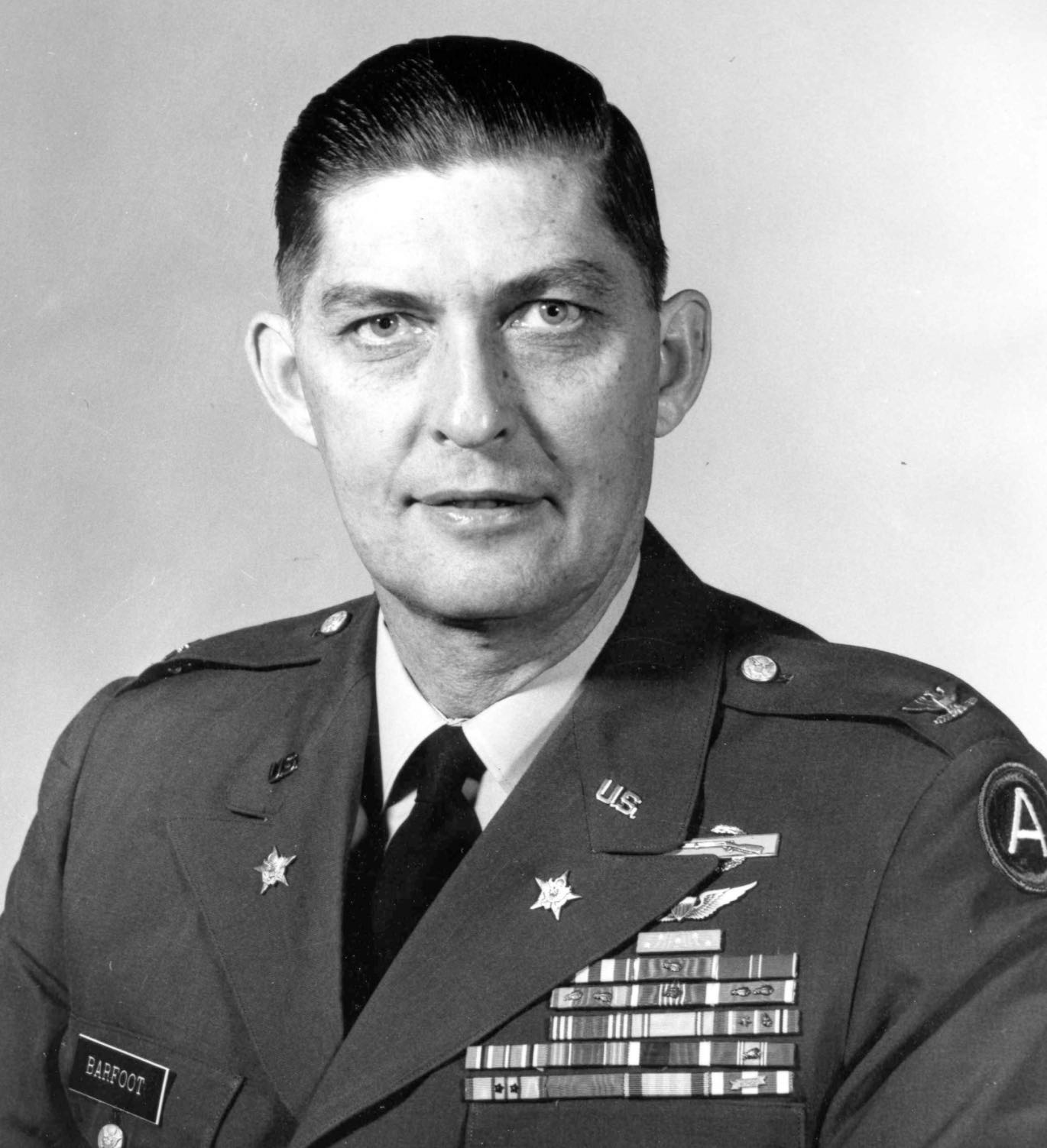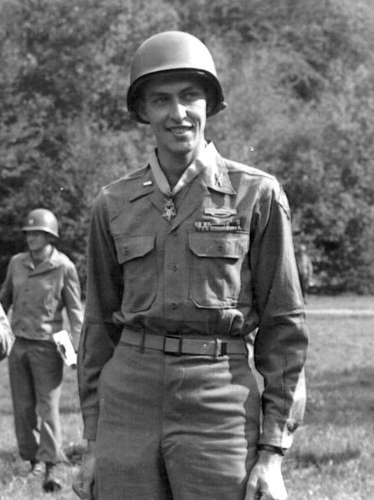Van T. Barfoot
Colonel
157th Infantry, 45th Division
June 15, 1919 – March 2, 2012

Col. Van T. Barfoot. U.S. Army
Van T. Barfoot enlisted in the U.S. Army on March 16, 1940. During World War II, he fought in Africa, Italy, and France. He was awarded the Medal of Honor, Silver Star, and the Purple Heart for his actions in Italy and was promoted from technical sergeant to lieutenant. In the mid-1940s, Barfoot’s prestige as a Medal of Honor recipient gave him a public platform to praise his fellow Black Soldiers and speak against racial discrimination in America. After World War II, Barfoot continued to serve in the Army during the Korean Conflict and the Vietnam War. Barfoot’s style of leadership earned him the respect of his fellow Soldiers.
Van Thomas Barfoot was born on June 15, 1919, near Carthage, Mississippi, to Simon and Martha Barfoot. His maternal grandmother was a member of the Choctaw Nation. He had two brothers and five sisters. He and his siblings helped on his father’s 35-acre cotton farm. Van learned how to hunt, and kept the family fed with duck, squirrel, and frog legs. Barfoot was raised in a religious family, and often credited his mother for instilling a sense of devotion and faith in God. He attended Edinburg School and completed a formal education level equivalent to the eighth grade before stopping to help his father harvest cotton.
During the Great Depression, Barfoot left home to join the Civilian Conservation Corps (CCC), which was one of President Franklin D. Roosevelt’s initiatives to help rebuild the country’s economy. While serving three years in the CCC, Barfoot traveled to Lexington, Mississippi, and Salem, Oregon. He gained skills as a ranger by studying forestry and fire control. His experience with hunting, and later with the CCC, helped prepare him for fighting in the mountains of Italy during World War II.
The growing tension in Asia and Europe was covered by newspapers and radio throughout the United States. As war erupted, Barfoot realized it was only a matter of time before the country would become involved in the fighting. Rather than waiting to be drafted, Barfoot took control of his own destiny and enlisted in the Army in March 1940. Due to his age , he needed his parents’ approval. He was initially trained by a battle-tested World War I veteran. He then traveled across the Eastern region for continued field and amphibious training. While he was training near Norfolk, Virginia, he met Norma Louise Davis. Although they talked about marriage, they decided to wait until after he returned from war. Shortly after his training in Virginia, Barfoot was assigned to the 157th Infantry Regiment.
The 157th Infantry Regiment left the Hampton Roads area of Virginia in June, 1943, and traveled via naval convoy. The convoy safely crossed the Atlantic Ocean and was not attacked. The infantry landed on African soil on June 25, 1943. As they climbed down the ship’s cargo net ladders near the beaches of St. Cloud, Algeria, Barfoot and his comrades received realistic amphibious landing training from American forces already established in the area. After a couple weeks of more training in Africa, the 157th loaded back onto the ships and headed to Italy.
Barfoot fought against the Germans in Salerno, Italy. He gained experience with conducting and leading patrols during this time, becoming a seasoned soldier, and took over as platoon sergeant while his unit advanced through the mountains. During a night patrol mission on Dec. 9-10, 1943, Barfoot destroyed three machine gun nests, killing at least five Germans and capturing two. He received the Silver Star for his actions.
When the 157th Infantry Regiment landed on the Anzio beachhead in Italy, they were met with fierce resistance from the German infantry, artillery, and Luftwaffe. The British and American forces spent the next four months trying to advance with little success. Entire American platoon companies were nearly wiped out by the Germans. During this time, patrols were sent out to gather information on German positions and activity.
In May, 1944, Barfoot’s unit was given orders to “jump off,” or advance, to the next location. They needed to cross a minefield that was under intense German crossfire. Barfoot was granted permission to move toward the left flank. Using hand grenades and a submachine gun, Barfoot took out three machine gun nests. He killed at least four enemy soldiers and captured 17. His actions allowed the platoon to cross the minefield without being fired upon. The Germans sent three Mark VI tanks as a counterattack. Barfoot grabbed a rocket launcher, called a bazooka, and positioned himself directly in their path. He disabled the lead tank and killed the crew as they tried to escape.
As his unit continued to advance, Barfoot came across a recently abandoned German artillery field piece. Rather than risk letting the large gun fall back into German hands, he destroyed it using demolition charges. When his assistant squad leader and platoon radio personnel became wounded, Barfoot summoned the strength to help bring them to safety.
Barfoot displayed quick thinking and bravery throughout his time fighting overseas. Once, during a night patrol in the Italian mountains, he had ventured farther than anticipated. Needing to cross a river to return to his platoon, Barfoot discovered that his patrol was surrounded by Germans. Refusing to surrender, Barfoot realized that, under the dark cover of night, their Army jackets could pass for German uniforms if they were turned inside out. Once the American Soldiers were disguised as much as possible, they snuck onto the back of a German truck and hitched a ride across a bridge. When it was safe, Barfoot and his team jumped out of the back of the truck, undetected, and made their way safely back to their platoon.
The Army commissioned Barfoot on June 21, 1944, promoting him from technical sergeant to second lieutenant , while he was still in Italy. When given the option to return to the United States to receive his Medal of Honor from President Roosevelt, Barfoot opted not to leave his men. He continued to fight as the infantry advanced into France, and in September 1944, he was presented his medal in the field by Lt. Gen. Alexander M. Patch III.

1st Lt. Van T. Barfoot receiving the Medal of Honor in Epinal, France, Sept. 22, 1944. U.S. Army
Barfoot’s childhood experience had prepared him for fighting overseas. But it was his experience fighting with Black troops in World War II that transformed his thoughts about discrimination and civil rights. In October 1944, Barfoot returned home hailed as a war hero and married Norma a month later. The following year, in 1945, Barfoot was publicly hosted by a congressional delegation from his home state of Mississippi. As he traveled by train to Washington, D.C., Barfoot confronted the racial segregation that still occurred. When it was time to eat, he was told by a waiter that he would have to wait because there wasn’t a place for him to sit in the dining car. Barfoot noticed a Black Army captain sitting by himself at a table and inquired about the empty seat. The waiter admitted that he didn’t think Barfoot would want to sit with the captain due to his race. Barfoot spoke up and said, “Why not? I’ve fought with colored men—why shouldn’t I eat with ‘em.” Ignoring segregation, Barfoot dined with the captain.
During the welcoming meeting with congressional delegates, Mississippi Senator Theodore Bilbo, who was known for promoting racially discriminatory practices, pointedly asked Barfoot about his experience serving with African Americans. Barfoot replied, “Mr. Senator, I found out after I did some fightin’ in this war [that the African Americans] fight just as good as the white boys. I have changed my ideas a lot about colored people since I got into this war, and so have a lot of other boys from the South. We’ve found the colored boys all right.” His response was not what Bilbo was expecting. Newspapers used the meeting, along with Barfoot’s anti-discrimination stance, to help highlight the esteem of Black troops and promote the Civil Rights movement.
Barfoot continued to serve in the Army during the Korean War. He attained the rank of colonel and served as a deputy aviation officer during the Vietnam War. His son also served during the Vietnam War as a medical evacuation pilot. Barfoot later became a senior national advisor to the Army National Guard for four years.
He made national headlines again in 2009 for refusing to comply with his community homeowner’s association rules over the display of the American flag on a flagpole in his front yard. The fight between Barfoot and the homeowner’s association became so public that a member from President Barack Obama’s administration made a comment supporting the Medal of Honor recipient, and Virginia governor Tim Kaine signed a law that made it illegal for any homeowner’s association to deny the proper display of the American flag. In 2009, the Mississippi Department of Transportation announced that it was naming a portion of Mississippi Highway 16 near Barfoot’s hometown of Carthage to honor the veteran. In 2022, Congressional and Department of Defense decisions led to the renaming of nine army bases. The Department of Defense announced that Fort Pickett, Virginia, would be renamed in honor of Barfoot, and in March 2023, a ceremony was held to commemorate the name change.
Barfoot passed away on March 2, 2012 at the age of 92. Throughout his life, he demonstrated moral and physical courage—courage to leave home at a young age to gain experience through the CCC program and later military service for his country, to speak up against racism to congressional delegates from Mississippi, and the courage to stand up for his rights as a homeowner. He remained true to the principles of faith instilled in him from his mother by reading Bible passages to his men before embarking on missions and combat, but willing to abandon his home state culture of racism. Barfoot was straightforward and humble, a leader who refused to forsake the men in his platoon, and earned the respect of not only his fellow Soldiers but of his country.
Katie Roxberry
Graduate Historic Research Intern
Sources
Barfoot, Van T. Interview by Dennis Smith, Van Thomas Barfoot Collection, Accession Number AFC/2001/001/70542, Veterans History Project, American Folklife Center, Library of Congress. https://www.loc.gov/item/afc2001001.70542/.
Barfoot, Van T. Interview by unknown interviewer, Van Thomas Barfoot Collection, Accession Number AFC/2001/001/89620, Veterans History Project, American Folklife Center, Library of Congress, 2002. https://www.loc.gov/item/afc2001001.89620/.
Pearson, Drew. “Merry-go-round.” Washington Post, January 18, 1945. http://proxygw.wrlc.org/login?url=https://www.proquest.com/historical-newspapers/merry-go-round/docview/151771219/se-2.
Shapiro, T Rees. “Medal of honor recipient battled to fly flag at Va. home.” Washington Post, March 6, 2012. http://proxygw.wrlc.org/login?url=https://www.proquest.com/newspapers/medal-honor-recipient-battled-fly-flag-at-va-home/docview/926242589/se-2.
United States Army. “History of the 157th Infantry Regiment (Rifle), 4 June 1943 – 8 May 1945.” Louisiana: Army & Navy Publishing Company, 1946. https://www.fold3.com/image/668108070/668107977.
U.S. War Department. “Press Releases and Related Records, 1942-1945.” Box 09: A 435- A 854, Ancestrylibrary.com. Image 110. https://www.ancestrylibrary.com/discoveryui-content/view/15747:3026?tid=&pid=&queryId=d790fcd944e1cf85832da829dcb1bcff&_phsrc=vqJ2&_phstart=successSource.
U.S. War Department. “Press Releases and Related Records, 1942-1945.” Box 10: A 885- B 124, Ancestrylibrary.com. Image 560-566. https://www.ancestrylibrary.com/discoveryui-content/view/1812:3026?_phsrc=GCH2&_phstart=successSource&gsfn=Van+T&gsln=Barfoot&ml_rpos=3&queryId=e125430f85cd710296ad0895b5a20331.
Additional Resources
“COL Van T. Barfoot.” Army Aviation Association of America. https://www.quad-a.org/Public/Awards/Awardees/BarfootV.aspx.
“Great Depression Facts.” Franklin D. Roosevelt Presidential Library and Museum. https://www.fdrlibrary.org/great-depression-facts.
Vrabel, Mike. “Virginia Guard’s Fort Pickett to be Redesignated Fort Barfoot.” U.S. Army. February 15, 2023. https://www.army.mil/article/264025/virginia_guards_fort_pickett_to_be_redesignated_fort_barfoot.
